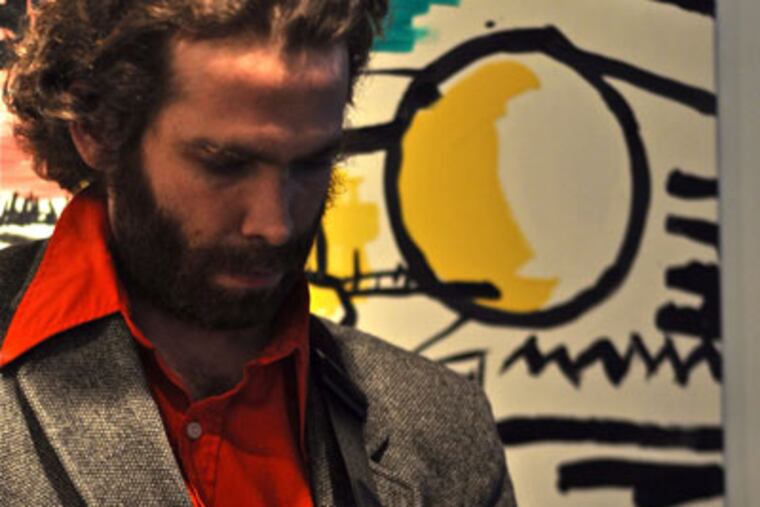Philadelphia art galleries add bands to their exhibits
WHAT WOULD Mona Lisa rock out to? Would she be a Beatles or a Stones girl? Or would she hide a love of punk rock behind the devilish smile? Mona Lisa may not have many musical options at the Louvre. But if she were to leave her home in Paris and head to Philly, she might be able to explore her musical side, as a crop of smaller galleries in the city are blurring the lines between art spaces and music clubs.

WHAT WOULD Mona Lisa rock out to? Would she be a Beatles or a Stones girl? Or would she hide a love of punk rock behind the devilish smile?
Mona Lisa may not have many musical options at the Louvre. But if she were to leave her home in Paris and head to Philly, she might be able to explore her musical side, as a crop of smaller galleries in the city are blurring the lines between art spaces and music clubs.
"It's almost like a one-night exhibition," said Daniel Dalseth, director of Queen Village's Pageant Soloveev. "It's a sound experience."
Kelani Nichole, a member of the Kensington-based art collective Little Berlin, agreed. "We like to think of art more broadly. Art doesn't mean painting on a wall for us," she said. "It's a full range of aesthetic for us. We want to create an evening that's a destination."
Putting on concerts in art galleries isn't new: Vox Populi has put on shows since the late '80s and the Highwire Gallery has booked shows in its many incarnations around the city since its inception. What is new is galleries such as Goldilocks Gallery and PhilaMOCA that function as hybrid spaces for art and music.
Center City's Goldilocks kicked off concerts officially last month with the record release party of the Bad Doctors, who play a high energy post-punk. Kamal Lamoza, owner and founder of Goldilocks, opened the space in August and had a smattering of DJ parties before the Bad Doctors show. He saw concerts as a natural extension of the space itself. The front room has floor-to-ceiling windows where they display visual art, but the gallery also features a back room that fits 200 people. "I think for , it's going along with the cultural trend that has been influenced by hip-hop culture, where they embrace visual art as well as music and culture," said Lamoza. "Young people just expect some kind of synergy or cooperation between different media in the arts."
Art galleries as venues have thrived particularly well in Philadelphia because, unlike in other big cities, the gallery scene here isn't solely made up of stodgy, white-walled arthouses. It's dominated by collectives, like Little Berlin and the Highwire Gallery. At Little Berlin, each member curates one month of art, meaning they are encouraged to bring in performances if it fits their theme for the month. Dalseth started booking bands almost by accident at Pageant Soloveev in 2004 because his friends in the now-defunct Need New Body needed a new venue at the last minute. Dalseth noticed that booking shows brings in people who don't often frequent art galleries. "We get more people in to the space and they can find out about what we're doing," he said. " expose a different audience to the artwork."
Vox Populi recently expanded its ability to mount concerts by opening Aux, a new space attached to its gallery north of Chinatown, that was made possible by grants from the Knight and William Penn foundations. "It's the more rough-and-tumble side of the gallery," said Gregory Rossi, programs coordinator at Vox Populi. Putting on shows allows Vox Populi to create a "social environment," according to Rossi, but it's also an extension of its mission to support emerging artists.
"With a lot of these groups, it's quite a departure from your standard rock 'n' roll-type of band with two guitars, a bass and a drum kit," Dalseth said. A venue not driven by the bottom line tends to be one of the places friendly to these bands. "When an establishment needs to turn a profit, which means bringing in audiences that will consume a lot of beer, free jazz isn't the genre to do that," said Steven Tobin, event curator of the Highwire Gallery in Fishtown.
Because putting on concerts isn't a gallery's main source of income, economic gain isn't at the forefront of curators' minds when booking concerts. "We're not doing these shows to make a bunch of money," Nichole said.
That viewpoint benefits bands. Tobin said he regularly mounts shows with bands that could play at more established places, such as Johnny Brenda's, but that happen to like the atmosphere a gallery provides, referring to Philly bands the Au Pairs and Many Arms. Tobin went as far to say that he will turn some acts away because they don't fit his experimental profile and could find other places to play.
Rachel Gagliardi and Nicole Snyder of the punk rock band Slutever prefer to play do-it-yourself spaces, regularly playing at Little Berlin and PhilaMOCA. These shows tend to be all-ages - selling alcohol is not an option for places without a liquor license - and they don't dictate high door prices. Art galleries, unlike a random basement in South Philly, for example, usually have permits in place and are less likely to get shut down by the city's Department of Licenses & Inspection.
It also guarantees that they won't get a crowd that's just there for warm place to get drunk. "I don't know if it's something you actively think about, but it influences the vibe of the show. Those environments and communities are very open and supportive and a lot less stuffy than, say, a bar show where everyone is there to get drunk and see music," Snyder said. "It's totally different." n
Contact Molly Eichel at 215-854-5909 or eichelm@phillynews.com, or follow on Twitter @mollyeichel. Read her blog posts at www.philly.com/entertainment.